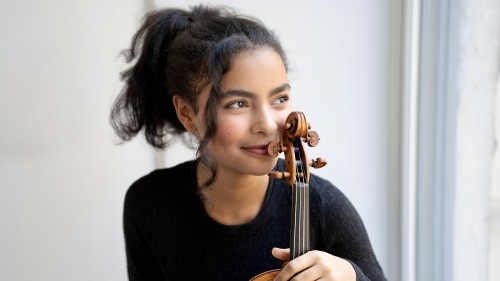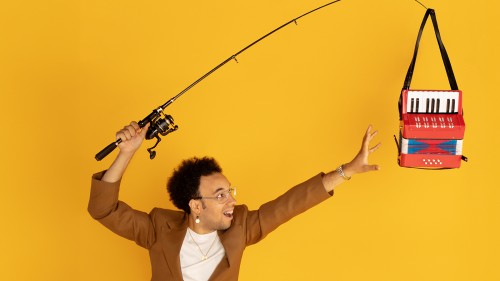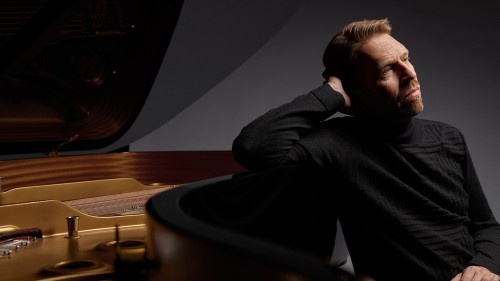
Meta4
For Those Departed
This site uses cookies to measure our traffic and improve your experience. By clicking "OK" you consent to our use of cookies.
PLEASE NOTE: There will be a limited number of obstructed view tickets in the balcony available for purchase in the lobby of the theater beginning one hour before the performance.
Born into a Moldavian family of popular folk musicians and later a student of violin and composition in Vienna and Bern, Patricia Kopatchinskaja performs a truly wide range of music. Dubbed as the wild child of the violin, “Pat Kop” is known as much for the passion and virtuosity of her playing as for her idiosyncratic trademark of playing barefoot. Now a megawatt star in high demand in Europe, Kopatchinskaja will be joined by her frequent collaborator Jay Campbell in a diverse duo program for her Boston recital debut. Praised by The New York Times for his “electrifying performances” which “conveyed every nuance,” Campbell has already forged a reputation as a spellbinding artist. The energy and intensity of these dynamic artists promise a truly memorable performance!
Read program notes
Trad. (11th c.) “Alleuia” from the Winchester Troper
Jörg Widmann 24 Duos for violin and cello (XXI and XXIV)
Orlando Gibbons Fantasia
Maurice Ravel Sonata for violin and cello
Iannis Xenakis Dhipli Zyia
Guillaume de Machaut Balade 4 (Biauté qui)
György Ligeti Hommage à Hilding Rosenberg
Zoltán Kodály Duo for violin and cello, Op. 7
“[Patricia Kopatchinskaja is] the most exciting violinist in the world…””
The Strad
“It is hard to characterize Campbell’s sound at the instrument, since it seems so perfectly tailored to each piece he plays.”
The Washington Post
This performance is made possible in part by support from Celebrity Series LIVE PERFORMANCE! Arts for All Innovation Funds.

For Those Departed

Debut Series


In the Footsteps of Piazzolla
Debut Series


Clarinetist Christopher Elchico & Friends
Traditional
“Alleluia” from the Winchester Troper
The Winchester Troper, the oldest surviving collection of two-part music in Europe, dates from the eleventh century. Its name comes from Winchester, Hampshire, a city sixty miles southwest of London, where the Winchester cathedral was founded in 642 CE; “Troper” refers to a collection of tropes, pieces of new music added to pre-existing plainchant (unaccompanied, free-flowing melodies sung in unison in Roman Catholic church services). In the Middle Ages, this tradition expanded to include two-voiced compositions called organum.
For centuries, the Winchester Troper was largely considered unreadable. Only in the past fifty years have scholars deciphered these ancient compositions and translated them into notation readable by modern-day performers. Among the 150 or so pieces collected in the Troper, fifty-three are “Alleluias.” The “Alleluia” performed here is characteristic of those in the collection, the two melismatic voices moving together in consonant harmony.
Jörg Widmann (b. 1973)
From 24 Duos for violin and cello
In the first edition of the published score, Widmann writes: “Violin and violoncello simultaneously form a comparable and incomparable pair. In these duos, both instruments are inseparably dependent on one another and cannot exist without each other. … Everything is interwoven, and everything one instrument does has consequences for the other. They attract each other, reject each other, love and hate each other, sometimes throw balls back and forth in play and then suddenly with an almost destructive intent. The playful elements of the work therefore always remain serious and the serious elements playful. Tricks and effects are totally absent: I have concentrated on the bare and essential musical substance right down to the most miniature phrases.
“Substantial parts of the duos were composed in distant Dubai. This seems to have proved to have been an extremely inspirational and productive time for me, even though the titles of certain movements such as ‘Valse bavaroise’ [Widmann was born and lives in the Bavarian capital of Munich] in Vol. 2 or the final piece in Vol. 1 ‘Four Verses of Homesickness’ tell of a different type of longing.”
Orlando Gibbons (1583-1625)
Fantasia a due, No. 4
During the Jacobean era, the twenty-two-year reign of King James I in the seventeenth century, viol playing was widely cultivated among the noble classes in English courts and universities. Orlando Gibbons was among those composers who met this demand with new works for viol (a string instrument played between the legs like a cello), writing nearly thirty pieces for the instrument in various configurations. This fantasia, like many from the period, eschews strict formal structures and projects an air of inspired improvisation, one player following the other in canon.
In Gibbons’ day, English noblemen would have been well-versed in The Book of the Courtier, a Renaissance-era guide to navigating the spoken and unspoken rules of courtly etiquette. Among these was the concept of sprezzatura, a studied carelessness that flaunted one’s skills while projecting an air of not trying too hard. Easy-but-not-too-easy works like Gibbons’ fantasias would have been well-suited to those wishing to impress without appearing desperate to impress.
Maurice Ravel (1875-1937)
Sonata for violin and cello
In March 1918, eight months before the Armistice, Claude Debussy, the leading figure in French music, lost a long battle with colon cancer. Cultural figures at home and abroad rushed to declare Ravel his successor. In London, The Times wrote “Since the death of Debussy he has represented to English musicians the most vigorous current in modern French music,” while in Paris, Ravel was awarded the Légion d’Honneur, which he flatly refused to accept. This newfound attention created a rift between the composer and some of his colleagues. In response, the already reserved Ravel bought a house (which he dubbed “Le belvédère”) in the suburbs of Paris and moved there with his three cats.
Ravel and Debussy had had a long and complex relationship, a professional rivalry based upon mutual respect which deteriorated amid sharp criticism and partisan debate. An early example of Ravel’s admiration for the older composer comes from his days in the Paris Conservatory when, against the wishes of his conservative professors, Ravel attended all fourteen performances of the first run of Debussy’s opera Pelléas et Mélisande.
Ravel wrote little in the years following the war, a nightmarish parade of death which stifled the composer’s creativity. Two years after Debussy’s passing, Henry Prunières, the editor of the then-new magazine La Revue musicale, invited composers to submit short musical tributes. Ravel’s submission would become the first movement of his Sonata for violin and cello. It took Ravel more than a year to shape the three remaining movements of the Sonata, one of the first works he completed after the war. Ravel was quite fond of the piece, calling it “a truly symphonic work for two instruments.” “The music is stripped down to the bone,” he added, “the allure of harmony is rejected and increasingly there is a return of emphasis on melody.”
The first movement, in three-part sonata form, opens with an obsessive violin ostinato; similar repeated patterns appear throughout the four movements. This device, one Ravel frequently employed, struck some of his contemporaries as mechanical: Igor Stravinsky dismissively referred to the Frenchman as a “Swiss watchmaker” who favored technique above emotionality.
The second opens with a nimble pizzicato exchange. These bars recall the pizzicato opening of the second movement of Ravel’s String Quartet—itself modelled on Debussy’s String Quartet, which also opens with plucked strings. This movement is far from melodious; it might be more accurately compared to a high-stakes ping pong match. Following a long silence, the music slows and softens before a raucous conclusion.
A mournful cello solo begins the slow movement. The violin enters in canon, playing the melody an octave higher. Halfway through, the music reaches a rupture and crescendos. Both instruments play the final third of the movement with mutes, seldom rising above a distant piano. The Sonata concludes with a rustic finale which culminates in a driving, sawing finish.
Iannis Xenakis (1922-2001)
Dhipli Zyia, for violin and cello
As a teenager, Xenakis studied music while simultaneously preparing to enter the civil engineering program at Athens Polytechnic. The Axis invasions halted his studies, and Xenakis soon found himself protesting in the streets. The occupation and subsequent retreat created a power vacuum that Greek political factions and outside forces rushed to fill, plunging the already devastated country into civil war. In 1944, a shell fragment from a British tank struck the left side of Xenakis’s face, leaving him scarred and blind in one eye. Soon after, Xenakis and other left-wing resistance fighters were punished for their role in the civil war. Condemned to death and stripped of his citizenship, Xenakis fled first to Italy, then to France in hopes of making it to the United States. Forced to remain in Paris as an illegal immigrant, he found employment in the studio of Swiss-French architect Le Corbusier.
One of Xenakis’s earliest works, Dhipli Zyia (“Duo”) dates from his first years in Paris. In his early period, Xenakis sought to emulate Béla Bartók’s synthesis of folk music with the techniques of European modernism. While working in Le Corbusier’s studio, Xenakis studied composition with various teachers, several of whom rejected him. He composed Dhipli Zyia while auditing the composition courses of Olivier Messiaen, who recognized his unique gifts and steered him away from lessons in traditional harmony and counterpoint.
Within Dhipli Zyia’s fast-slow-fast structure, Xenakis evokes Greek folk dances and the plucking of lyre and lute. The music is often aggressive, its irregular meters constantly changing. Xenakis had only just begun to explore the intersections of sound, three-dimensional space, and mathematics in his music, a fascination which would soon emerge in his first major composition, Metastaseis.
Guillaume de Machaut (c.1300-1377)
Balade 4: Biauté qui
Poet and composer Guillaume de Machaut is unusual among his contemporaries for the sheer amount of his work which survives, largely due to Machaut’s careful preservation. Trained to be a court secretary, Machaut compiled volumes devoted entirely to his own music and verse. While much is known about Machaut the musician and poet—Geoffrey Chaucer, author of The Canterbury Tales, was a fan—his biography remains shrouded in mystery.
“Balade” has its origins in the Provençal balar, “to dance.” Over the centuries, the derivative “ballad” came to be associated almost exclusively with sung text; today, ballads are nearly synonymous with sentimental tear-jerkers or bombastic torch songs. The text, penned by Machaut, tells of a lovesick man pining for a distant beloved, the titular “beauty to equal all others.” Each of the three stanzas ends with the same refrain: “All these things have brought me to the point where I will die for love.” Such maudlin subject matter was standard fare for Machaut and the noble class for whom he often wrote.
György Ligeti (1923-2006)
Hommage à Hilding Rosenberg
The full title, Tribute to Hilding Rosenberg’s Birthday (Evoking the Spirit of Bartók), names two preeminent musical modernists of the twentieth century. Rosenberg, one of the first modernist Swedish composers, helped steer Swedish composition away from earlier Romantic traditions. Ligeti and Rosenberg had met and struck up a friendship while teaching at the University of Stockholm in the 1960s. Ligeti composed this tribute to his colleague in 1982 on the occasion of Rosenberg’s ninetieth birthday.
Ligeti’s connection to fellow Hungarian Béla Bartók dates to the former’s teenage years. In an interview conducted the year he wrote this piece, Ligeti remarked, “I was very much impressed by Bartók. You know, he was the great Hungarian composer…. Bartók was the big genius: I think he still is, for me.”
A defining feature of Ligeti’s œuvre is his use of polyphony, the independent movement of melodic lines. One of Ligeti’s most famous compositions, Atmosphères, contains myriad slow-moving lines interacting in what Ligeti termed “micropolyphony.” Ligeti explained, “you cannot actually hear the polyphony, the canon. You hear a kind of impenetrable texture, something like a very densely woven cobweb.” By contrast, the melodic independence in Hommage à Hilding Rosenberg is limited by its small number of players. The music moves quickly, creating flashes of dissonant and ever-changing harmonies. Despite the piece’s celebratory genesis, “Happy Birthday to You” it is not. Descending chromatic lines indirectly reference Hungarian funeral laments Ligeti heard as a boy. The resonant open strings which close the work provide a sonic reset.
Zoltán Kodály (1882-1967)
Duo for violin and cello, Opus 7
Zoltán Kodály spent his youth in the countryside near Budapest. Alongside the folk music Kodály absorbed from classmates and neighbors, his parents exposed him to music from the Classical era. He attended the Academy of Music in Budapest, where he wrote his dissertation on the structure of Hungarian folk song. Shortly after, the Academy hired him as a professor where he taught alongside Béla Bartók. Together, the two would become pioneers in the burgeoning field of ethnomusicology, spending years collecting, recording, and cataloging indigneous folk tunes. This work had a tremendous influence on Kodály’s own compositions. While the majority of his works are folk song settings, even the instrumental works are deeply indebted to Kodály’s immersion in Hungarian folk music.
The first movement of this work places violin and cello in extended dialogue. Following the bold and lyrical introduction, the violin introduces the movement’s primary theme, a winding melody which begins with an upward leap. The instruments trade this melody throughout the movement, one always accompanied by the other’s plucked strings. The cello closes with a slow, heavy tune as the violin evokes the sawing of a peasant fiddle.
In the mournful and aggressive Adagio, Kodály explores the rich palette of tone colors in both instruments, at times overtly contrasting them. In one passage, the violin intones a rich, full-voiced melody as the cello plays an accompaniment of thin, wispy arpeggios. In the final bars, the violin plays with a mute while unmuted cello imitates the breathy timbre of a flute.
A majestic, lilting violin solo opens the third and final movement, its florid passagework interrupted by short, plucked duets. After this introduction, the music shifts gears into a boisterous Presto. The instruments dart around one another before careening across the last pages.
© Andrew McIntyre, 2020
Stay in touch with Celebrity Series of Boston and get the latest.
Email Updates Sign up for Email Updates